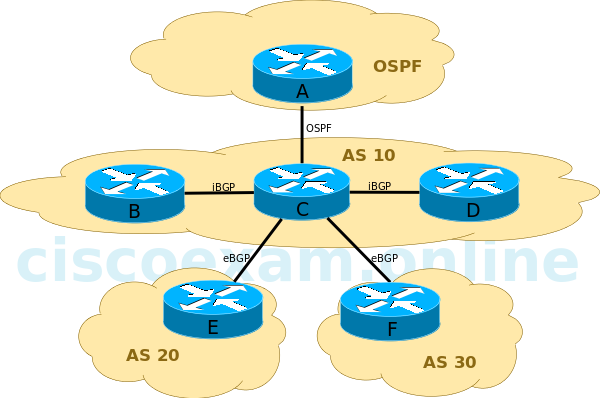
You administer the networks shown above. RouterA is connected to network A, RouterB is connected to network B, and so on.
RouterA and RouterC are OSPF neighbors. RouterB and RouterD are iBGP peers of RouterC; RouterE and RouterF are eBGP peers of RouterC.
RouterC, which is not configured as a route reflector, receives routes from all of the other routers on the network. You have issued the network command on each router to advertise their respective networks. You have also issued the redistribute command on RouterC to redistribute the OSPF routes from RouterA into BGP.
Question: RouterC will advertise to RouterD routes to which of the following networks?
| A. |
only networks B and C | |
| B. |
only networks A and C | |
| C. |
only networks A, B and C | |
| D. |
only networks C, E and F | |
| E. |
only networks A, C, E and F | |
| F. |
only networks A, C, B, E and F | |
| G. |
all networks (A, C, B, D, E and F) |
RouterC will advertise only networks A, C, E, and F to RouterD. RouterC and RouterD are internal Border Gateway Protocol (iBGP) peers, which are BGP routers that exist within the same autonomous system (AS). The BGP split horizon rule states that routes learned through iBGP are not advertised to iBGP peers. Therefore, only routes learned through external BGP (eBGP), routes learned through redistribution, and routes originated by a network statement are advertised to iBGP peers. In this scenario, the routes to networks E and F are learned through eBGP, the route to network A is learned through redistribution, and the route to network C originated on RouterC.
RouterC will not advertise network B to RouterD, because RouterC learned of network B through an iBGP peer, RouterB. iBGP routes are not advertised to iBGP peers.